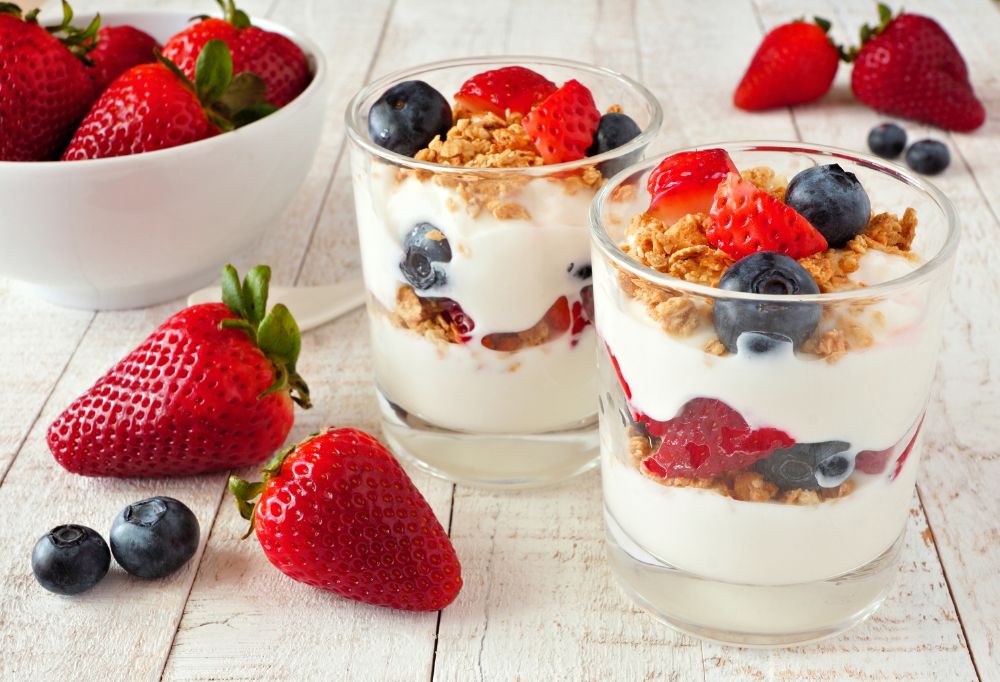Reviewed by Taylor Consiglio, PA-C of Forum Health Medical Weight Loss
At a Glance…
- Protein is critical for weight loss, especially for women over 40.
- Higher protein intake increases appetite-reducing hormones and decreases hunger hormones.
- Recommended daily protein in-take for male and female adults
- High protein recipes for breakfast, lunch and dinner
If you’re looking to shed extra weight or want to maximize your results while on a GLP-1 weigh loss medication, protein intake is an essential component that can contribute to your success.
Learn why protein consumption is important to regulate hunger and how much protein you need daily, plus try one of our mouthwatering, high-protein recipes from breakfast to dinner that are perfect to support your weight loss goals.
What Role Does Protein Play in Weight Loss?
Your weight is regulated by your hypothalamus, an area of the brain that produces hormones to control body temperature, heart rate, hunger, appetite, and mood.
For your brain to determine when and how much to eat, it relies on processing various signals in the body, with hormones being the most crucial to regulate eating patterns.
Eating foods higher in protein increases the appetite-reducing hormones such as: GLP-1, peptide YY, and cholecystokinin; and decreases the hunger hormone, ghrelin.
Including more protein in your daily nutrition can lead to an automatic reduction in overall calorie intake and can also provide these other benefits, including:
- Satiety: Protein is highly satiating, meaning it helps you feel fuller longer compared to carbohydrates or fats. When you consume protein-rich foods, they trigger the release of hormones that signal fullness to your brain, reducing your appetite and overall calorie intake.
- Thermic Effect of Food (TEF): Protein has a higher thermic effect compared to carbohydrates and fats, meaning your body expends more energy (calories) to digest and metabolize protein. This increased calorie expenditure can aid in weight loss by boosting your metabolism.
- Muscle Preservation: When you’re in a calorie deficit to lose weight, there’s a risk of losing muscle mass along with fat. Adequate protein intake helps preserve lean muscle mass, ensuring that the weight you lose comes primarily from fat stores rather than muscle tissue. This is essential for maintaining metabolic health and achieving a toned physique.
- Increased Metabolism and Calorie Burn: Protein can also indirectly increase calorie burn. Muscle tissue is metabolically active, meaning it burns calories even at rest. By preserving and building lean muscle mass through adequate protein intake, you can enhance your overall calorie expenditure, supporting weight loss efforts.
- Nutrient Density: Many protein-rich foods, such as lean meats, poultry, fish, legumes, nuts, and seeds, are also rich in essential nutrients like vitamins, minerals, and antioxidants. Choosing these nutrient-dense protein sources as part of a balanced diet ensures that you meet your body’s nutritional needs while consuming fewer calories, promoting weight loss and overall health.
How much protein do I need to support weight loss and muscle retention?
Now that you know how important protein is for weight loss and overall health, you’re probably wondering, “how much protein exactly do I need every day?”
The recommended daily intake of protein varies depending on your age, gender, weight, activity level, and overall health status. Generally, 10% – 35% of your calories should come from protein according to the Mayo Clinic.
Further, general guidelines for protein intake for adult females and adult males based on activity level:
Adult Females Recommended Protein Intake:
- Sedentary: About 46 grams per day
- Moderately active: About 46-56 grams per day
- Active: About 56-75 grams per day
Additionally, women over 40 may require more protein due to age-related factors such as decreased muscle mass, changes in metabolism, and hormonal shifts due to menopause.
Adult Males Recommended Protein Intake:
- Sedentary: About 56 grams per day
- Moderately active: About 56-75 grams per day
- Active: About 75-98 grams per day
These recommendations are based on the Dietary Reference Intakes (DRIs) established by health authorities such as the Institute of Medicine (IOM) in the United States and may vary slightly in other countries. It’s important to note that individual protein needs can vary based on factors such as muscle mass, metabolic rate, and specific health goals.
Discover Delicious High-Protein Recipes to Boost Weight Loss
Breakfast: Protein-Packed Amaranth Breakfast Bowl

Ingredients:
- 1/2 cup amaranth
- 1 cup almond milk (or any plant-based milk of your choice)
- 1 tablespoon almond butter
- 1/2 cup mixed berries (such as strawberries, blueberries, raspberries)
- 1 tablespoon chopped nuts (such as almonds, walnuts, or pecans)
- 1 teaspoon maple syrup or honey (optional)
- Pinch of cinnamon (optional)
Instructions:
- Rinse the amaranth under cold water using a fine-mesh sieve.
- In a saucepan, combine the rinsed amaranth and almond milk. Bring to a boil over medium heat.
- Once boiling, reduce the heat to low, cover, and simmer for 20-25 minutes, or until the amaranth is cooked and the liquid is absorbed. Stir occasionally to prevent sticking.
- Once the amaranth is cooked, remove from heat and let it sit, covered, for a few minutes to allow any remaining liquid to absorb.
- Transfer the cooked amaranth to a bowl. Stir in the almond butter until well combined.
- Top the amaranth with mixed berries, chopped nuts, and a drizzle of maple syrup or honey, if desired.
- Sprinkle with a pinch of cinnamon for extra flavor, if desired.
- Serve warm and enjoy your protein-packed plant-based breakfast bowl!
Lunch: Grilled Chicken and Quinoa Salad

Ingredients:
- 2 boneless, skinless chicken breasts
- 1 cup quinoa
- 2 cups mixed greens (spinach, kale, arugula)
- 1 bell pepper, diced
- 1 cucumber, diced
- 1/4 cup cherry tomatoes, halved
- 1/4 cup crumbled feta cheese
- Juice of 1 lemon
- 2 tablespoons olive oil
- Salt and pepper to taste
Instructions:
- Cook quinoa according to package instructions and let it cool.
- Season chicken breasts with salt, pepper, and a squeeze of lemon juice. Grill until cooked through, then slice into strips.
- In a large bowl, combine cooked quinoa, mixed greens, bell pepper, cucumber, cherry tomatoes, and grilled chicken strips.
- Drizzle olive oil and lemon juice over the salad, then toss gently to coat.
- Sprinkle crumbled feta cheese on top and serve immediately.
Snack: Protein-Packed Parfait

Ingredients:
- 1 cup Greek yogurt
- 1/2 cup mixed berries (strawberries, blueberries, raspberries)
- 1/4 cup granola
- 1 tablespoon honey (optional)
Instructions:
- In a glass or bowl, layer Greek yogurt, mixed berries, and granola.
- Drizzle honey on top if desired for added sweetness.
- Repeat the layers until all ingredients are used up.
- Serve immediately as a nutritious breakfast or satisfying dessert option.
Dinner: Baked Salmon with Asparagus

Ingredients:
- 2 salmon fillets
- 1 bunch asparagus, trimmed
- 2 cloves garlic, minced
- 2 tablespoons olive oil
- 1 tablespoon lemon juice
- 1 teaspoon dried dill
- Salt and pepper to taste
Instructions:
- Preheat oven to 400°F (200°C) and line a baking sheet with parchment paper.
- Place salmon fillets and asparagus on the prepared baking sheet.
- In a small bowl, whisk together minced garlic, olive oil, lemon juice, dried dill, salt, and pepper.
- Pour the mixture over the salmon and asparagus, ensuring they are evenly coated.
- Bake in the preheated oven for 12-15 minutes, or until the salmon is cooked through and flakes easily with a fork.
- Serve hot and enjoy the flavorful combination of tender salmon and roasted asparagus.
Incorporating high-protein recipes into your weight loss journey is a smart and delicious way to achieve your weight loss and overall health goals. These recipes are not only packed with protein but also bursting with flavor and nutrients to keep you feeling full and satisfied.
Whether you’re enjoying a protein-packed salad, a flavorful seafood dish, or a creamy yogurt parfait, you’ll be one step closer to reaching your desired weight while nourishing your body with wholesome ingredients.
Have questions about weight loss?
Forum Health Medical Weight Loss offers a comprehensive weight loss program to help you look and feel your best by addressing the root cause of your weight loss resistance. We don’t just focus on short-term weight loss, but also on long-term weight maintenance.
Your personalized weight-loss plan may include injectable GLP-1 medications, peptides, nutritional supplements, accountability health coaching, lifestyle and nutrition counseling, and much more to help you achieve real results.









